Investigation
How could the acoustic control of the noise pollution from the Barcelona airport facilitate the biotic activity of L’Hospitalet de Llobergat’s delta park?
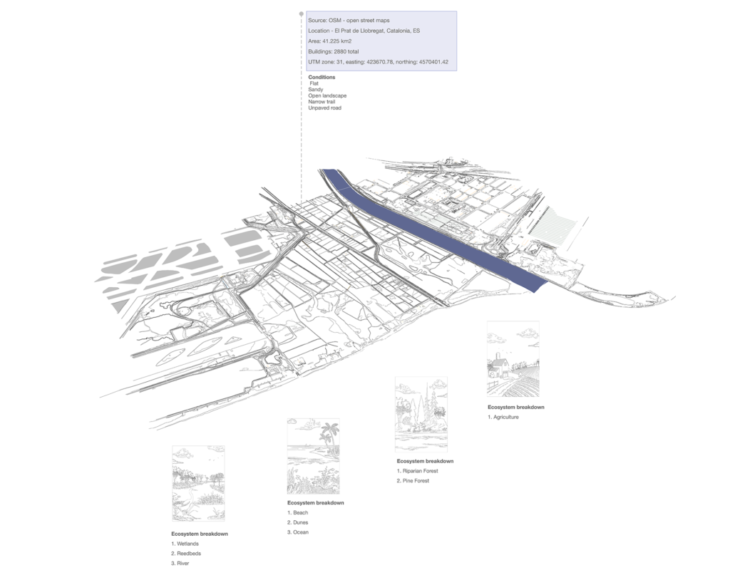
Introduction
The municipal edge of Barcelona that intercepts with L’Hospitalet de Llobergat is highly contested, both environmentally and infrastructurally. The delta exit and park are very important biomes along said edge because they host families of organisms and micro-organisms that demonstrate change as a result of, but not limited to, a man-made infrastructure that is neighboring the delta park, Barcelona’s airport. The biomes in this zone are many and they have been birthed by the shifted delta exit, the eccentric environments in the delta park, Zona Franca’s industrial grounds, Llobergat’s agricultural land, and the rippled sky which witnesses the endless arrivals of airplanes from heights of 50 to 20 meters above ground. The following video attempts to convey the mood, sound, and components of the site of interest
Observations
The site witnessed periodic plane arrivals between heights of 50 to 20 meters and 75 to 103.8 Decibels. Jets interrupted the arrival of commercial planes and they were speedier and louder. The very loud noise emitted by airplanes was very audible and polluting. Birds reacted with aggression that was later quantified and qualified. A local gave a testimony that conveyed future plans of the airport to extend a fourth lane going through the delta park. The disturbance has caused the mitigation of small mammals which has caused the ‘recourceless-ness’ of predators that feed on said escaped prey. This undermines the health of the ecosystem. Chiffchaffs decreased their song rate when exposed to aircraft noise. Evidence in insects showed brooding behavior of ants and increased heart rate of caterpillars which affects their health.
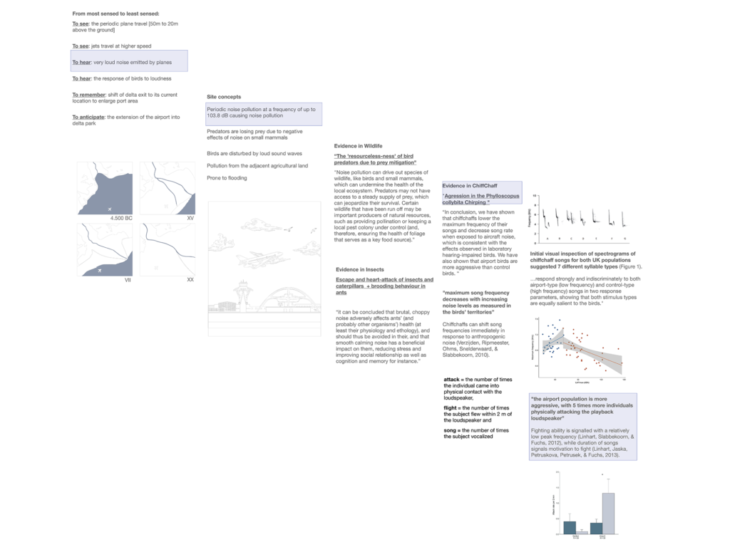
Samples were collected from the site such as the Spanish Broom [Spartium], unidentified Seeds, spider webs containing seeds, ant house sand, droppings, heron feather, and more. They were mixed with yeast in a petri dish and sterilized at 35 degrees Celcisus. This has allowed the morphology of colonies and the resulted bacteria was identified for future prospect of research.
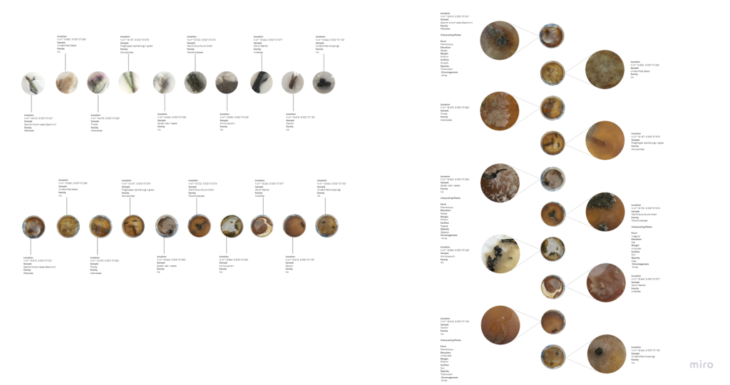
Species
The Chiffchaff is a small migratory bird that dwells at the top of trees and builds its nest closer to the ground. Males generally defend their territories by singing throughout the breeding season. Impacts from aircraft sound could be measured by decreased song frequency, aggression, evasion of predators, and mating frequency. Among its predators include the Peregrine Falcon, a species whose permanent population is not abundant in the area. However, fleets currently trained to control bird strikes fly over their territory, and with the airport expansion would likely increase. The Latin name for Chiffchaff means leaf-seeker, and they can be found seeking prey such as caterpillars here which also feed almost entirely on plants. The sound impact indicator in this species would be changes in its dorsal vessel, strongly related to its movement and in turn feeding habits. Beneath the ground near the Chiffchaff nest, ants can be found aerating the soil and digging tunnels for their own nests. The sound impact indicator in this species would be their movement, orientation, behavior, and cognition. The traits of these species are quintessential to measure the impact of any potential intervention that aims to avoid the destruction of their biotic functions. A visitation to these traits directly after the deployment of any intervention would allow one to understand its the impact and sustainability.
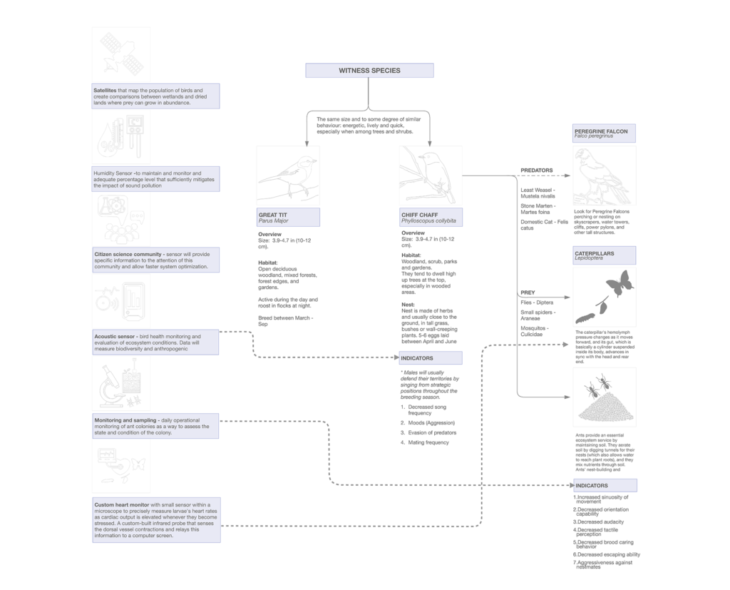
Ecological Function
The first response was the introduction of planting that relies on water, such as aquaponics. The effect of this would be two fold resulting in the expansion of agriculture which is of immense economic importance to the city and the eventual aquaculture through the addition of water that aids in mitigating the effects of noise pollution. The intervention ensures the appropriate foliage to areas of bird population density to guarantee year-round soundproofing. This will also aid in providing additional forage for pollinators population. Thirdly, the introduction of changes to the topography in order to deflect sound waves. This would be achieved by adding a layer of concave mounds made up of dry and granular soil. Another aim is to introduce sprinklers that allow non-agricultural lands to maintain the appropriate humidity level, since the more the moisture the lesser vibrations occur. The technologies to achieve these functions were split into two: environmental tools and tools relating to the indicators of our witness species. For starters, satellites that map the population of birds and create comparisons between wetlands and dried lands where species can grow in abundance was introduced. Relating to the introduction of water humidity sensors would be used to maintain and monitor and adequate level that sufficiently mitigates the impact of sound pollution. These efforts would be highly reliant on experts and a community of citizen scientists. This allows quick reaction to the information.
In terms of tools relating to the indicators of the witness species, acoustic sensor may be utilized for bird health monitoring and for evaluation of ecosystem conditions. Based on data obtained from acoustic sensors , once can measure the level of anthropogenic disturbance and the health of the birds. Then through monitoring and sampling, daily operational monitoring of ant colonies would be a way to assess the state and condition of the colony and soil health. Custom heart monitors that measure larvae’s heart rates as cardiac output is elevated whenever they become stressed are essential indicators for caterpillars’ condition.
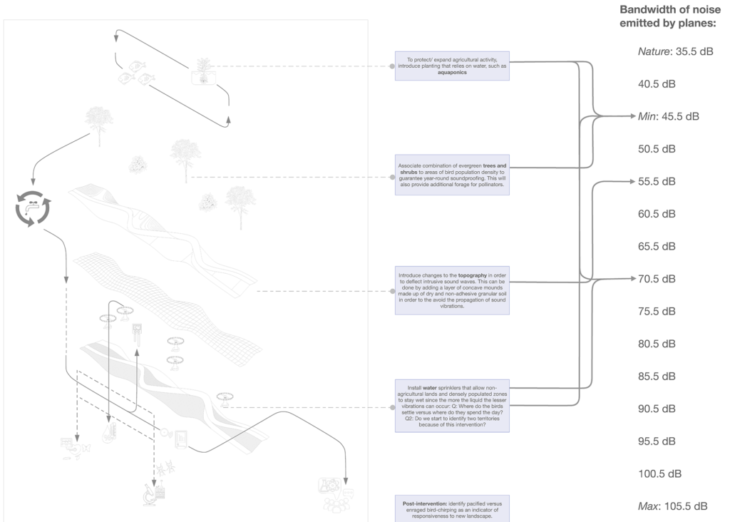
Connections between interventions and target Decibels
Metabolic Diagram
The metabolism diagram is a spiral of the researchers’ investigation that narrates a chronology of events and findings while cross-referencing the where, what, who, how, and why. The organisms demonstrating change are connected to the Decibels both directly and by transitive.
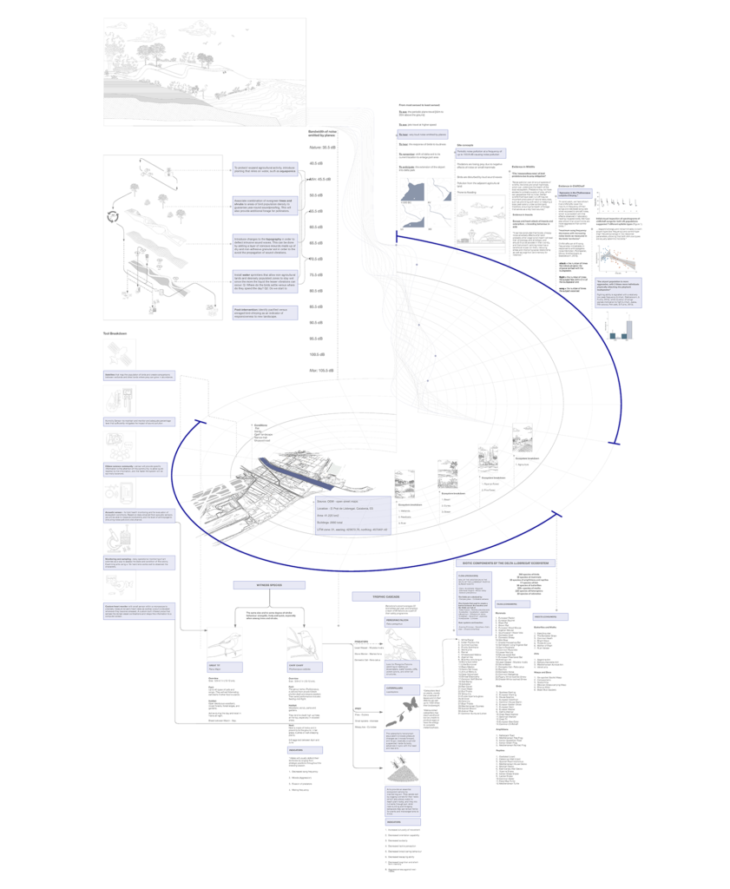

Open databases of raw images, videos, test results, and morphologies.
Acoustic Control for Biotic Function is a project of IAAC, Institute for Advanced Architecture of Catalonia, developed at the Master in Advanced Architecture in 2021 by students: Nader Akoum, Solene Cais, and Alessandra Weiss; faculty: Jonathan Minchin
